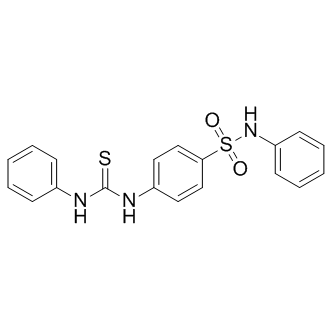
LED-209
CAS No. 245342-14-7
LED-209( LED 209 | LED209 )
Catalog No. M13713 CAS No. 245342-14-7
LED-209 is a bacterial conserved membrane histidine sensor kinase QseC inhibitor.
Purity : >98% (HPLC)
 COA
COA
 Datasheet
Datasheet
 HNMR
HNMR
 HPLC
HPLC
 MSDS
MSDS
 Handing Instructions
Handing Instructions
| Size | Price / USD | Stock | Quantity |
| 10MG | 38 | In Stock |


|
| 50MG | 163 | In Stock |


|
| 100MG | 244 | In Stock |


|
| 200MG | Get Quote | In Stock |


|
| 500MG | Get Quote | In Stock |


|
| 1G | Get Quote | In Stock |


|
Biological Information
-
Product NameLED-209
-
NoteResearch use only, not for human use.
-
Brief DescriptionLED-209 is a bacterial conserved membrane histidine sensor kinase QseC inhibitor.
-
DescriptionLED-209 is a bacterial conserved membrane histidine sensor kinase QseC inhibitor; prevents autophosphorylation and inhibits QseC-mediated activation of virulence gene expression; inhibits the virulence of several pathogens in vitro and in vivo in animals.
-
In Vitro——
-
In Vivo——
-
SynonymsLED 209 | LED209
-
PathwayGPCR/G Protein
-
TargetAntibacterial
-
RecptorQseC
-
Research AreaInfection
-
Indication——
Chemical Information
-
CAS Number245342-14-7
-
Formula Weight383.4872
-
Molecular FormulaC19H17N3O2S2
-
Purity>98% (HPLC)
-
SolubilityDMSO: < 3.8 mg/mL
-
SMILESS=C(NC1=CC=C(S(=O)(NC2=CC=CC=C2)=O)C=C1)NC3=CC=CC=C3
-
Chemical NameBenzenesulfonamide, N-phenyl-4-[[(phenylamino)thioxomethyl]amino]-
Shipping & Storage Information
-
Storage(-20℃)
-
ShippingWith Ice Pack
-
Stability≥ 2 years
Reference
1. Rasko DA, et al. Science. 2008 Aug 22;321(5892):1078-80.
2. Spencer H, et al. J Bacteriol. 2010 Feb;192(3):714-24.
3. Xue XY, et al. Nanomedicine. 2015 Feb;11(2):329-39.
molnova catalog



related products
-
Quorum Sensing-IN-3
Quorum Sensing-IN-3 (QS-IN-1) is a compound with inhibitory effects on bacterial community sensing, which inhibits the exchange of information between bacteria and inhibits biofilm formation.
-
Azidamfenicol
Azidamfenicol inhibits ribosomal peptidyltransferase with a Ki of 22 μM. Azidamfenicol is a broad-spectrum chloramphenicol-like antibiotic.
-
(Rac)-AMXT-1501 4HCl
(Rac)-AMXT-1501 4HCl is a polyamine transport inhibitor that inhibits polyamine transport and acts synergistically with cisplatin in HNSCC.



 Cart
Cart
 sales@molnova.com
sales@molnova.com


